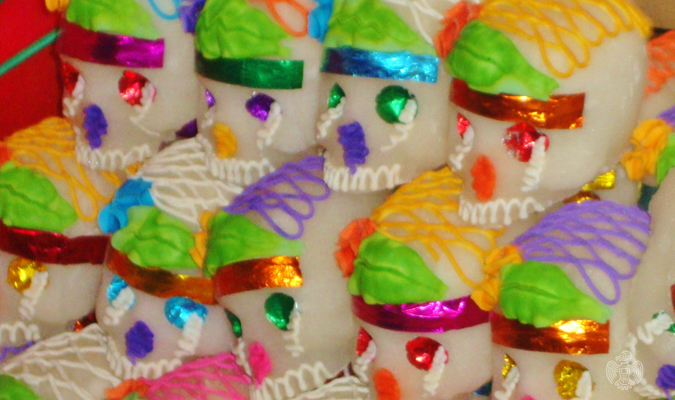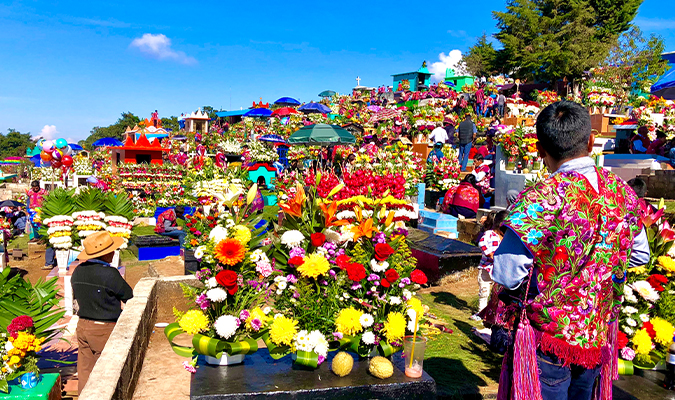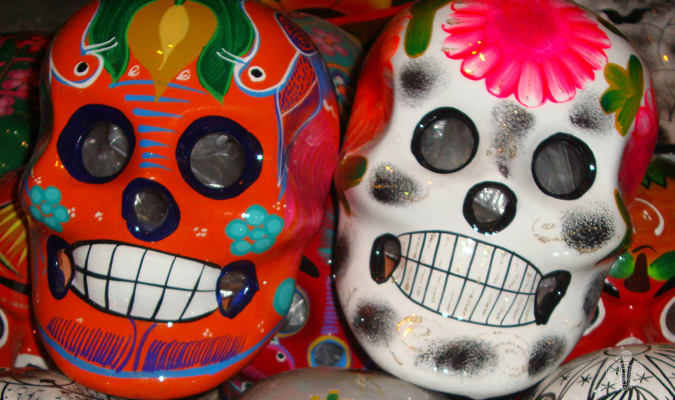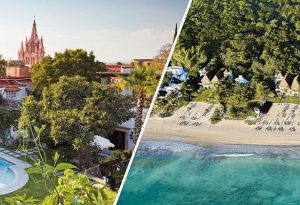Day of the Dead, or Dia de los Muertos, is an often misunderstood holiday celebrated in Mexico. It originated from a centuries-old Aztec festival in honor of Mictecacihuatl, a goddess known as the Lady of the Dead. Since it follows Halloween, some people might conclude that it is the same holiday or an evil holiday praising death, but that couldn’t be farther from the truth. November 1st is traditionally referred to as Dia de los Angelitos (Day of the Little Angels) in Mexico and is the day to honor infants and children who have died; followed by November 2nd, the actual Dia de los Muertos, when families tribute adults whom they have lost. It is believed that on these days, the souls of the deceased return to earth to be with their families and loved ones.
The mood of these holidays will vary from grievance to humorous as relatives reminisce about funny events and anecdotes of their loved ones. One of Mexico’s most prominent symbols of Dia de los Muertos are the Catrina figures (little statues of skeletons dressed in formal clothing) which originated as a parody poking fun at upper class Mexican females. Another tradition involves reciting short poems called calaveritas (little skulls), which are mockingly funny verses poking at the quirky habits or comical events of the deceased and their past.
It is important to note that the celebrations for these holidays vary widely throughout the different regions of Mexico. In some areas, the cemetery plays a larger role in celebrations than in others where the home is the center of celebrations where altars and ofrendas are built. The favorite food and beverage of the deceased are often taken to graves and alters to honor the dead and in some regions, people celebrate the loss of children by hosting dinners consisting of specific foods and sweets. Costumes, body paint, and imagery of skulls and bones are often important in many areas of Mexico when celebrating these holidays as well.
Day of the Dead in San Miguel de Allende
As November approaches, families stream in and out of local cemeteries to scrub tombstones, clear away weeds and lay out flowers and candles. In the weeks before the celebration, a special market is set up near the Plaza Civica where everyone shops for decorations among stalls of sugar skulls, miniature coffins, skeleton puppets and the familiar skeleton masks and figures, known as calacas. The city annually celebrates The Calaca Festival hosting various artistic and cultural events for children and adults. Read more about Day of the Dead in San Miguel Allende here or take a read through our suggested itinerary and contact Journey Mexico to begin planning your trip.
Day of the Dead in Oaxaca
Oaxaca transforms during Dia de los Muertos as the city prepares to welcome their loved ones spirits back to earth. The week traditionally starts with “Plaza de los Muertos” commencement where the marketplaces start to sell everything related to Dia de los Muertos traditions: pan de muerto, calaveras, papel picado, cempasuchils, incense, and so forth. With this, families can buy what they need to create their colorful and vibrant altars in their homes. Arcs of bright cempasuchils provide a welcome to spirits who are crossing over. For visitors, Oaxaca has elaborate Day of the Dead altars set up throughout the town and sand tapestry competitions.
Travel with Journey Mexico and we’ll craft a fully personalized itinerary to let you experience Day of the Dead on your owns terms without the hassle of traveling with a group. Take a read through our suggested itinerary to get a feel of what your Day of the Dead in Oaxaca could be. We suggest planning at least 1 year in advance.
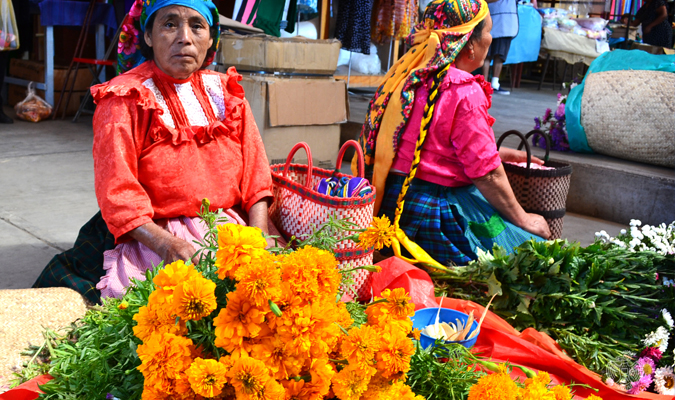
Day of the Dead in Mixquic, Mexico City
While Mexico City holds several events to commemorate the traditions and icons of Dia de los Muertos, the greatest immersion can be found in Mixquic. In the center of this neighborhood is one of Mexico City’s oldest cathedrals and surrounding it is it’s cemetery. A incredible altar and intricate tapete sit at the end of the church adored with gold. Candlelight processions and mourning families join in the graveyard at their loved ones tombstone throughout the night. Outside the gate is a complete change of scenery; the neighborhood is a full fair with rides, carnival games, face painting, and entertainment including artistic performances and interpretations of the holiday. Most interestingly, there is a museum that shows a documentary of Dia de los Muertos in Mixquic and how traditions are being influenced by Halloween.
Day of the Dead in Chiapas
In the pretty highland pueblo of San Cristóbal de las Casas, colorful altars can be seen lining the streets, decorated with candles, swirling copal incense and the deceased’s favorite food and drink. Such a sensorial display has the intention of guiding the dead back to the realm of the living for one day. Wandering around town, visitors can soak up the atmosphere of Day of the Dead in Chiapas with music, exhibits, and performances put on in the streets.
In surrounding towns like Zinacantán and Amatenango del Valle, Tzotzil Maya communities pay respect to their dead with graveyard festivities, flower displays, and exchanging stories of their departed loved ones. Take a read through our suggested itinerary to see how you can partake in these intimate moments with a local family.
Day of the Dead in Aguascalientes
Aguascalientes is the birthplace to Jose Guadalupe Posada, the artist who created the La Catrina symbol that is now very representative of Dia de los Muertos. The city celebrates with a 10 day festival called Festival de las Calaveras. The festival is intended to rescue and preserve the traditions of Dia de los Muertos and pay tribute to Jose Posada. Artists fill the festival recreating some of Posada’s images and actors participate in thematic tours. Cinematic performances, music shows, a Skulls’ Parade, altar building contest, and pan de muerto contest are also important parts to the festival’s celebration.
Day of the Dead in Michoacan
In the Magic Town of Patzcuaro, Michoacan there is a small island called Janitzio that many Purepecha indigenous people call home. This indigenous group, also known as Tarascans, have elaborate Dia de los Muertos rituals that include processions to the cemetery where they stay night until dawn singing and praying. It is tradition that the women and children create ofrendas (offerings) above their loved ones tomb while the men gather together to drink and admire from afar. When dark falls, candles illuminate the way to the cemetery, a ritual considered scared by the community.
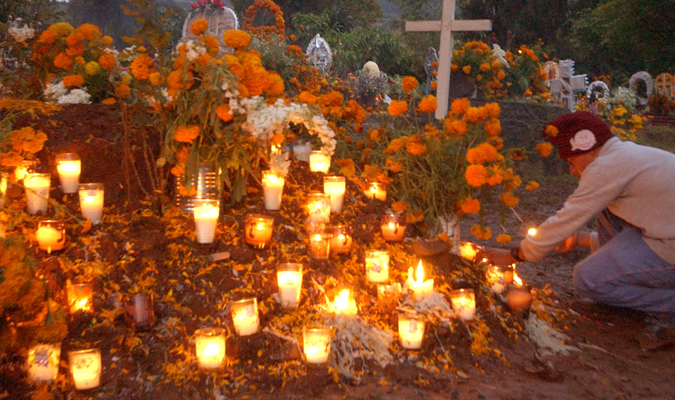
Day of the Dead in Yucatan Peninsula
In the Yucatán Day of the Dead is known as ´Hanal Pixan´, meaning ´Food for the Souls´ in Mayan. In celebration of these special dates, families prepare the traditional dish ´Mucbipollo´. This large tamale-esque specialty is made with corn dough and stuffed with fresh vegetables, herbs, and meat or poultry. Once wrapped in banana leaves, the mucbipollo is cooked in a pre-Hispanic pit oven in the ground called a ´pib´. To celebrate the lives of their beloved souls, communities create beautiful altars in their homes that are thoughtfully decorated with photos, flowers, candles, and food. This altar ritual is a meaningful way to remember the deceased during Hanal Pixan.
Day of the Dead in Riviera Maya/Cancun
Riviera Maya hosts an annual Festival de la Vida y la Muerte (Festival of Life and Death) at Xcaret park in honor of the Dia de los Muertos. At this festival, visitors are encouraged to participate in music and dancing, shop for Day of the Dead trinkets, and try typical Yucatecan fares. Guests can watch parade performance and tour the cemetery to learn about the Mayan burial rituals.
Book a Day of the Dead tour in Mexico
The Day of the Dead celebration is one of the most colorful, moving, and authentic cultural experiences one can have in Mexico. While the festivities differ throughout Mexico, the requirement of planning does not (we recommend at least one year in advance). If you’re interested in traveling to Mexico for Day of the Dead, contact Journey Mexico today.


